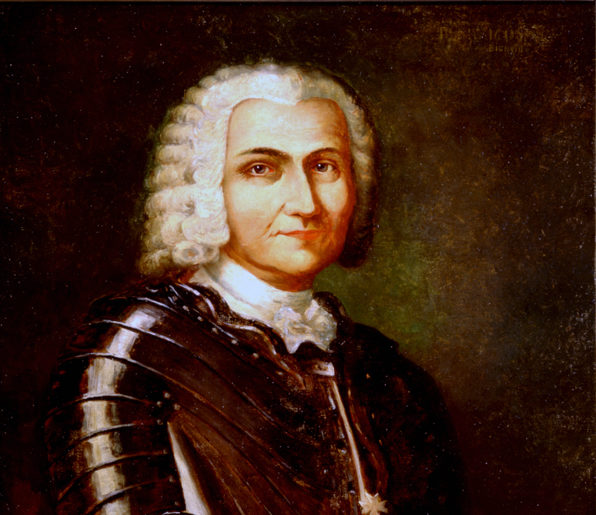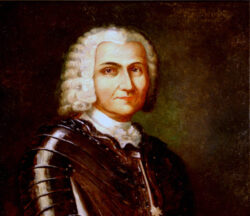Jean-Baptiste Le Moyne, sieur de Bienville
Jean-Baptiste Le Moyne, sieur de Bienville was a Canadian naval officer who, with his brother Pierre Le Moyne d'Iberville, explored the lower Mississippi River Valley in 1699 and established the first permanent French settlement in Louisiana.

Courtesy of Louisiana State Museum
Jean Baptiste Le Moyne, sieur de Bienville. Bohunek, Rudolph (Artist )
Canadian naval officer Jean-Baptiste Le Moyne, sieur de Bienville, served as three-time governor of the French colony of Louisiana intermittently from 1702 to 1743. Bienville and his older brother, Pierre Le Moyne d’Iberville, traveled on an expedition that arrived in Louisiana in 1699. Together they explored the lower Mississippi River valley and established a permanent French settlement in Louisiana, Fort Maurepas. Bienville proved particularly talented, though not always successful, as a negotiator with local Native Americans. In 1718, he chose the site where New Orleans, named for the French Duc d’Orléans, was built.
Early Life
Jean-Baptiste Le Moyne, sieur de Bienville, was born February 23, 1680, in the frontier village of Montreal to Charles and Catherine Le Moyne. He went to school at the Sulpician Seminary of Montreal before entering the French navy as a midshipman at the age of twelve. He served with his brother, Iberville, in Newfoundland in 1696, where he campaigned for the expulsion of English fishermen, and Hudson Bay, where he was wounded during a battle to recapture Port Hudson in 1697. Afterwards, he returned to France with Iberville and prepared for a 1698 expedition to Louisiana; he was eighteen years old.
From 1699 to 1702, Bienville assisted Iberville in establishing a permanent French settlement in Louisiana. He played a key role in identifying Mobile Bay and the mouth of the Mississippi River. During this time, he demonstrated an exceptional ability to learn native languages and negotiate with local groups of Bayogoula and Houma Indians. Iberville made Bienville second in command of Fort Maurepas in 1700. When Iberville returned temporarily to France, Bienville conducted several exploratory expeditions through the rivers, bayous, and lakes in the lower Mississippi valley. On one such expedition, he famously convinced the captain of an English corvette to cease his descent down the Mississippi River at a point later called “English Turn.” Also in 1700, Bienville accompanied Louis Juchereau de St. Denis, twenty Canadians, and several Tensas guides up the Red River in search of the legendary Spanish mines, but to no avail.
Leadership in Louisiana
Bienville assumed command of Fort Maurepas when the commandant of the post died in 1701. Upon Iberville’s final return to Louisiana in 1702, Bienville was appointed governor of the colony and ordered to lead the construction of a post on Dauphin Island and another (Fort Louis) at Mobile. During his first tenure as governor of Louisiana from 1702 to 1713, Bienville struggled to manage military and commercial alliances with native groups around Mobile, several of which were in contact with English traders from the Carolinas. Chickasaw and Choctaw Indians, the two largest and most powerful nations in the region, proved especially important to Bienville’s plans for the colony. It was during this time that Bienville organized annual gift-giving ceremonies with local chiefs in Mobile and followed lex talionis, or the law of retaliation (sometimes simplified as a policy of an “eye for an eye”), in matters of diplomacy and warfare.
Among his European counterparts, Bienville gained a reputation for quarreling with the Roman Catholic clergy, mismanaging royal funds, and conducting extramarital affairs with French women of the colony. The Minister of Marine ultimately responded to Bienville’s apparent indiscretions by appointing Nicolas Daneau de Muy as the new colonial governor and Jean-Baptiste Martin d’Artaguette Diron as the new ordonnateur, or commissary, with authority to investigate accusations against Bienville. De Muy died he died before arriving in Louisiana, however, and Bienville was never found guilty, so he remained governor until sieur Antoine de la Mothe Cadillac, the former founder and commandant of Detroit, arrived as his replacement in 1713.
The governorship of Cadillac coincided with the cession of the colony to the financier Antoine Crozat. Though not governor, Bienville retained considerable influence over the colony’s Indian affairs, especially after Cadillac insulted the Natchez and precipitated an armed conflict. The establishment of Fort Rosalie on the Mississippi River was the result of Bienville’s diplomatic efforts with the Natchez. In 1717, Crozat abruptly relinquished his fifteen-year monopoly after only five years. The monopoly was then transferred to the Company of the West (later the Company of the Indies) led by the financier John Law. A year later, Bienville was awarded the Cross of St. Louis and appointed commandant general, effectively making him governor of the colony.
Later Career
One of Bienville’s first duties as commandant was to establish a town thirty leagues up the Mississippi River and name it after the Duc d’Orléans. In 1718, Bienville chose a site on the east bank of the river where there was a “fine crescent,” though it was not until 1722 that New Orleans became the capital of the colony. He received two parcels of land in the vicinity of New Orleans, which were cleared and worked by some of the first enslaved Africans in Louisiana. In 1719, when France declared war on Spain, Bienville led a successful assault against the Spanish fort at Pensacola, though it was returned to the Spanish at the conclusion of the War of the Quadruple Alliance in 1722. In 1720, Law’s financial system collapsed in France, leaving hundreds of recent European immigrants in deplorable conditions and the future of Louisiana in question. A reorganized Company of the Indies attempted to repair the damage left in the wake of Law’s collapse. Prior to his recall to France in 1725, Bienville suppressed a Natchez uprising and came under the investigation of the royal commissioner Jacques de la Chaisse for financial improprieties.
Étienne de Périer replaced Bienville as governor of Louisiana in 1725. In the disastrous aftermath of the 1729 Natchez Revolt, however, French officials summoned Bienville back to Louisiana in 1732. Bienville immediately set out to repair relations with native groups of the lower Mississippi valley. The Choctaw were especially important to Bienville’s scheme to curtail the influence of the Chickasaw and the English in Louisiana. He ordered four expeditions against the Chickasaw (1733, 1736, 1740, and 1742), all of which resulted in a combination of military and diplomatic failure. Bienville submitted his letter of resignation to the Minister of Marine in 1742. A year later, the Marquis Pierre de Rigaud de Vaudreuil de Cavagnial arrived in New Orleans to replace the man who had resided in Louisiana for thirty-six years. Bienville spent the rest of his life as a bachelor in Paris, where he died on March 7, 1767.
